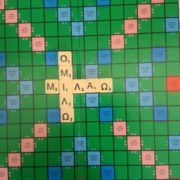“Énan moussaká, parakaló” This is how Omilo students attending Greek courses in Greece order one of their favorite Greek dishes. When you visit Greece, you will definitely enjoy Greek cuisine and Greek food culture. Moussakas is the symbol of Greek cuisine, a dish you can find in most taverns in any season. Learn its history and try to cook a delicious moussaka, following our recipe.
Moussakas is one of the most famous Greek dishes: it contains aubergines, potatoes, minced meat and béchamel sauce. Tourists know and love this dish already from Greek restaurants in their homeland. Homemade moussakas is prepared by mothers and grandmothers for family meals. It is an urban dish, that is, it is made by people who can devote much time to its preparation. There are four stages of cooking: frying for aubergines and potatoes, boiling for the béchamel, browning for the mince, baking at the end.
About moussakas’ history
Moussakas origins from the East. We find it in the Balkans, in the Middle East, in Central Europe (Hungary) and in Turkey. The Greek version of moussaka was created in 1920s by chef Nikolaos Tselemendes from Sifnos. He gave moussaka the form we know today by adding the French béchamel sauce on top and by removing the excessive spices. In Greece, moussakas is served hot in square pieces from the baking tray.
The word moussakas is of Arabic origin and has been transferred into Greek through Turkish. Others say it comes from the Persian maguma, a lamb and eggplant dish, or from the Palestinian musakhkhan (something heated, warmed up), a dish with chicken and onion wrapped into a special bread and baked in the oven. It seems that Persians brought eggplant from India, but Ottomans spread recipes with eggplant, such as imam baildi (a dish with whole eggplants stuffed with onion, garlic and tomatoes). Minced meat is of Arabic-Persian origin.
Greek Language Note: non-Greeks and restaurants abroad usually pronounce it as Mou-sA-ka, with the stress on the first A.
However, in modern Greek, the correct pronunciation is with the stress on the last A, so Mou-sa-kA
If you use it in “nominative case”, then it is Mou-sa-kAs, so with an extra “s” at the end…but let’s not get into too much grammar today, but simply enjoy the dish 🙂
Moussaka recipe
Ingredients:
1 kilo large eggplants
4 large potatoes
For the mince:
½ kilo minced meat
½ cup olive oil
1 large finely chopped onion
2 finely chopped garlic cloves
½ cup of wine
½ bunch of parsley
1 tin tomato puree
1 tablespoon concentrated tomato paste
1 cinnamon stick
3-4 allspice granules
Salt and pepper
For the béchamel sauce:
2 cups grated parmesan
4 tablespoons butter
6 tablespoons flour
1 ½ liter fresh milk or 1 tin of evaporated milk
2 cups of water (if you use tinned milk)
a bit of nutmeg
1 egg yolk
Preparation of the mince:
1. Heat the oil in a pan and slightly brown the onion.
2. Add the minced meat and brown it, stirring constantly.
3. Add the garlic, the cinnamon and the allspice.
4. Season with salt and pepper.
5. Pour the wine into the mince and add the parsley.
6. Add the tomato puree and concentrated tomato paste and stir.
7. Leave it on the fire until all the fluid has been absorbed.
Preparation of the béchamel sauce:
1. Melt the butter in a pan.
2. Heat the milk (if using tinned milk, dilute with water first).
3. Add the flour to the melted butter while constantly stirring.
4. When it becomes a thick paste, start adding the hot milk very slowly while stirring to prevent clotting. Do not pour any more milk unless the previous has been completely absorbed.
5. Add the egg yolk and nutmeg and stir well…
Instructions:
1. Cut the eggplants into round slices.
2. Put them into a bowl with salt and water.
3. Peel and cut the potatoes into round slices and then fry them.
4. Rinse the eggplants slices and fry them too.
5. In an oven tray, place the potato slices in a layer.
6. Place most of the eggplant slices on top (to fill the gaps)
7. Put the mince on top.
8. Lay the remaining eggplants slices on top.
9. Prepare the béchamel sauce and spread it over the eggplant.
10. Sprinkle with cheese and/or breadcrumbs.
11. Bake at medium heat in the oven.
We wish you good luck and of course “enjoy your meal”
Καλή όρεξη








